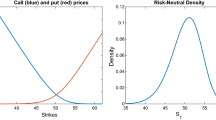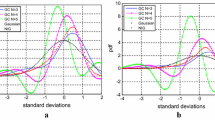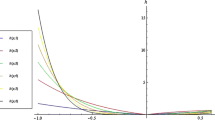Abstract
In practice, a reliable and flexible estimation of risk-neutral density from empirical data is a challenging task since it can not be observed directly from the market. In this study, we apply Bernstein polynomial basis to recover the risk-neutral density function from the observed price quotes of European-type option contingent on an underlying asset. More importantly, we perform an extensive simulation study to examine the flexibility and robustness of the proposed method in recovering different shapes of the true risk-neutral density function from noisy option price quotes. Also, we compare the proposed method with other two popular nonparametric methods namely the constrained local linear polynomial smoothing and the smoothed implied volatility smile reported in the literature. Accuracy and stability of the three nonparametric methods are assessed by the root mean integrated square error criterion. The simulation results show that the proposed method is flexible as it exhibits the various shapes of the true risk-neutral density function even when the volatility is high. Moreover, in comparison with the other two methods, the proposed approach is robust and yields more accurate densities even in the presence of noise. Finally, we demonstrate the applicability of the proposed method in recovering a smooth risk-neutral density function from the S&P 500 market index option data.


Similar content being viewed by others
Notes
Time-value of the call option = \(C(K) - \max (S_{t}e^{-q \tau } - Ke^{-r \tau },0)\).
The inversion of the hessian matrix \(\mathbf H _{N-1}\) becomes numerically unstable for large N (Wang and Ghosh 2012).
\(P_{i}'s\) are obtained using the put-call parity relation: \(C_{i} - P_{i} = e^{- rT}(F - K_{i})\).
References
Aït-Sahalia, Y., & Duarte, J. (2003). Nonparametric option pricing under shape restrictions. Journal of Econometrics, 116(1), 9–47.
Aït-Sahalia, Y., & Lo, A. W. (1998). Nonparametric estimation of state-price densities implicit in financial asset prices. The Journal of Finance, 53(2), 499–547.
Aït-Sahalia, Y., & Lo, A. W. (2000). Nonparametric risk management and implied risk aversion. Journal of Econometrics, 94(1), 9–51.
Aparicio, S., & Hodges, S. (1998). Implied risk-neutral distribution: A comparison of estimation methods, FORC Preprint. University of Warwick.
Bahra, B. (1997). Implied risk-neutral probability density functions from option prices: Theory and application, Bank of England Working Paper No. 66.
Banz, R. W., & Miller, M. H. (1978). Prices for state-contingent claims: Some estimates and applications. Journal of Business, 51, 653–672.
Bates, D. S. (1996). Jumps and stochastic volatility: Exchange rate processes implicit in deutsche mark options. Review of Financial Studies, 9(1), 69–107.
Bates, D. S. (2000). Post-’87 crash fears in the S&P 500 futures option market. Journal of Econometrics, 94(1), 181–238.
Bates, D. S. (2003). Empirical option pricing: A retrospection. Journal of Econometrics, 116(1), 387–404.
Benko, M., Fengler, M., Härdle, W., & Kopa, M. (2007). On extracting information implied in options. Computational Statistics, 22(4), 543–553.
Birke, M., & Pilz, K. F. (2009). Nonparametric option pricing with no-arbitrage constraints. Journal of Financial Econometrics, 7(2), 53–76.
Black, F., & Scholes, M. (1973). The pricing of options and corporate liabilities. The Journal of Political Economy, 81, 637–654.
Bliss, R. R., & Panigirtzoglou, N. (2002). Testing the stability of implied probability density functions. Journal of Banking & Finance, 26(2), 381–422.
Bondarenko, O. (2003). Estimation of risk-neutral densities using positive convolution approximation. Journal of Econometrics, 116(1), 85–112.
Breeden, D. T., & Litzenberger, R. H. (1978). Prices of state-contingent claims implicit in option prices. Journal of Business, 51, 621–651.
Brunner, B., & Hafner, R. (2003). Arbitrage-free estimation of the risk-neutral density from the implied volatility smile. Journal of Computational Finance, 7(1), 75–106.
Bu, R., & Hadri, K. (2007). Estimating option implied risk-neutral densities using spline and hypergeometric functions. The Econometrics Journal, 10(2), 216–244.
Campa, J. M., Chang, P. K., & Reider, R. L. (1998). Implied exchange rate distributions: Evidence from OTC option markets. Journal of International Money and Finance, 17(1), 117–160.
Carr, P. (2001). Constraints on implied volatility. Working Paper. Bank of America Securities.
Chak, P. M., Madras, N., & Smith, B. (2005). Semi-nonparametric estimation with Bernstein polynomials. Economics Letters, 89(2), 153–156.
Celis, O. S., Liang, L., Lemmens, D., Tempère, J., & Cuyt, A. (2015). Determining and benchmarking risk neutral distributions implied from option prices. Applied Mathematics and Computation, 258, 372–387.
Cooper, N. (1999). Testing techniques for estimating implied RNDs from the prices of European-style options. In Proceedings of the BIS workshop on implied PDFs. Basel: Bank of International Settlements.
Cox, J. C., & Ross, S. A. (1976). The valuation of options for alternative stochastic processes. Journal of Financial Economics, 3(1), 145–166.
Farouki, R. T. (2012). The Bernstein polynomial basis: A centennial retrospective. Computer Aided Geometric Design, 29(6), 379–419.
Feng, P., & Dang, C. (2016). Shape constrained risk-neutral density estimation by support vector regression. Information Sciences, 333, 1–9.
Fengler, M. R. (2009). Arbitrage-free smoothing of the implied volatility surface. Quantitative Finance, 9(4), 417–428.
Fengler, M. R., & Hin, L. Y. (2015). Semi-nonparametric estimation of the call-option price surface under strike and time-to-expiry no-arbitrage constraints. Journal of Econometrics, 184(2), 242–261.
Figlewski, S. (2008). Estimating the implied risk neutral density for the US market portfolio. Volatility and time series econometrics: Essays in Honor of Robert Engle. Oxford University Press.
Floater, M. S. (2005). On the convergence of derivatives of Bernstein approximation. Journal of Approximation Theory, 134(1), 130–135.
Floudas, C. A., & Visweswaran, V. (1995). Quadratic optimization. In Handbook of global optimization (pp. 217–269). Berlin: Springer.
Garcia, R., & Gençay, R. (2000). Pricing and hedging derivative securities with neural networks and a homogeneity hint. Journal of Econometrics, 94(1), 93–115.
Healy, J. V., Dixon, M., Read, B. J., & Cai, F. F. (2007). Non-parametric extraction of implied asset price distributions. Physica A: Statistical Mechanics and its Applications, 382(1), 121–128.
Heston, S. L. (1993). A closed-form solution for options with stochastic volatility with applications to bond and currency options. Review of Financial Studies, 6(2), 327–343.
Jackwerth, J. C. (1999). Option implied risk-neutral distributions and implied binomial trees: A literature review. Journal of Derivatives, 7(2), 66–82.
Jackwerth, J. C. (2004). Option-implied risk-neutral distributions and risk aversion. Research Foundation of AIMR Charlotteville.
Kundu, A., Kumar, S., Tomar, N. K., & Gupta, S. K. (2016). Call option price function in Bernstein polynomial basis with no-arbitrage inequality constraints. Journal of Inequalities and Applications, 1(2016), 1–16.
Lee, S. H. (2014). Estimation of risk-neutral measures using quartic B-spline cumulative distribution functions with power tails. Quantitative Finance, 14(10), 1857–1879.
Lorentz, G. G. (2012). Bernstein polynomials. Providence: American Mathematical Society.
Malz, A. M. (1997). Estimating the probability distribution of the future exchange rate from option prices. The Journal of Derivatives, 5(2), 18–36.
Melick, W. R., & Thomas, C. P. (1997). Recovering an asset’s implied PDF from option prices: An application to crude oil during the gulf crisis. Journal of Financial and Quantitative Analysis, 32(01), 91–115.
Melick, W. R., & Thomas, C. P. (1998). Confidence intervals and constant maturity series for probability measures extracted from option prices. Paper Presented at the Bank of Canada Conference on Information Contained in Prices of Financial Assets.
Monteiro, A. M., Tütüncü, R. H., & Vicente, L. N. (2008). Recovering risk-neutral probability density functions from options prices using cubic splines and ensuring nonnegativity. European Journal of Operational Research, 187(2), 525–542.
Ritchey, R. J. (1990). Call option valuation for discrete normal mixtures. Journal of Financial Research, 13(4), 285–296.
Rookley, C. (1997). Fully exploiting the information content of intra day option quotes: Applications in option pricing and risk management. Tucson: University of Arizona.
Ross, S. A. (1976). The arbitrage theory of capital asset pricing. Journal of Economic Theory, 13(3), 341–360.
Rubinstein, M. (1994). Implied binomial trees. The Journal of Finance, 49(3), 771–818.
Shimko, D. (1993). Bounds of probability. Risk, 6, 33–37.
Söderlind, P. (2000). Market expectations in the UK before and after the ERM crisis. Economica, 67(265), 1–18.
Söderlind, P., & Svensson, L. (1997). New techniques to extract market expectations from financial instruments. Journal of Monetary Economics, 40(2), 383–429.
Wang, J., & Ghosh, S. (2012). Shape restricted nonparametric regression with Bernstein polynomials. Computational Statistics & Data Analysis, 56(9), 2729–2741.
Wang, Y., Yin, H., & Qi, L. (2004). No-arbitrage interpolation of the option price function and its reformulation. Journal of Optimization Theory and Applications, 120(3), 627–649.
Yatchew, A., & Härdle, W. (2006). Nonparametric state price density estimation using constrained least squares and the bootstrap. Journal of Econometrics, 133(2), 579–599.
Acknowledgements
The first author is grateful to the Ministry of Human Resource and Development, India for the financial support to carry out the work. The authors greatly appreciate the anonymous reviewer and the editor for their helpful comments and suggestions that led to significant improvements in the presentation and quality of the article.
Author information
Authors and Affiliations
Corresponding author
Technical Appendix: Alternative Techniques for RND Estimation
Technical Appendix: Alternative Techniques for RND Estimation
Here, we provide an overview of two existing methodologies for the RND estimation, namely the CLLPS and the SML methods.
1.1 Constrained Local Linear Polynomial Smoothing (CLLPS) Method
Aït-Sahalia and Duarte (2003) have proposed a fully nonparametric regression method based on constrained local polynomial kernel smoothing to recover the RND. To recover the RND, the authors have suggested the algorithm that contains the following three steps.
-
Step 1 (constrained least squares regression) Constrained least squares regression is used to correct the option prices such that it satisfies a set of constraints in an arbitrary way. For a given sample of observations \(\{K_{i},C_{i}\}_{1\le i \le n}\), where \(C_{i}\) is the price of the call option with strike \(K_{i}\), solve the constrained least squares regression problem
$$\begin{aligned} \min _{\pmb m \in {\mathbb {R}}^{n}}\sum _{i=1}^{n}(C_{i}-m_{i})^{2}, \end{aligned}$$(32)subject to:
$$\begin{aligned}&\frac{m_{i+2} - m_{i+1}}{K_{i+2}-K_{i+1}} \ge \frac{m_{i+1} - m_{i}}{K_{i+1}-K_{i}} ~~\forall ~~i = 1:n-2, \end{aligned}$$(33)$$\begin{aligned}&-e^{-r\tau } \le \frac{m_{2} - m_{1}}{K_{2}-K_{1}} ~~\text {and}~~ \frac{m_{n} - m_{n-1}}{K_{n-1}-K_{n}} \ge 0, \end{aligned}$$(34)Suppose, \(\pmb m\) is the desired solution vector of (32).
-
Step 2 (local linear polynomial Smoothing) To obtain local linear polynomial smoothing estimator \({\hat{m}}(K)\), solve the following local least squares problem
$$\begin{aligned} \min _{\alpha _{0,1}, \alpha _{1,1}} \sum _{i=1}^{n}\bigg (\mathbf m _{i}-\alpha _{0,1}(K) - \alpha _{1,1}(K)\times (K_{i}-K)\bigg )^{2}K_{h}(K_{i}-K), \end{aligned}$$(35)where \(\alpha _{0,1}\) and \(\alpha _{1,1}\) are the unknown coefficients and \(K_{h}(K_{i}-K)\) is the kernel function defined as \(K_{h}(K_{i}-K) \equiv K(K_{i}-K)/h\). Here h is a smoothing parameter which can control the goodness of fit and smoothness of the estimator. Then \({\hat{m}}(K) ={\hat{\alpha }}_{0,1}(K)\) and its first derivatives \({\hat{m}}^{(1)}(K) \equiv {\hat{m}}_{11} \equiv 1!{\hat{\alpha }}_{1,1}(K)\).
-
Step 3 (scaling and shifting process) Apply scaling and shifting process on the \({\hat{m}}^{\prime }_{11}\), where \(\prime \) stands for differentiation. Finally, call price function is estimated as
$$\begin{aligned} C_{{ ASD}}(K) = \int _{K}^{\infty }(S_{T}-K){\hat{m}}^{\prime }_{11}(S_{T})dS_{T}. \end{aligned}$$(36)
1.2 Smoothed Implied Volatility Smile (SML) Method
The SML method was first proposed by Shimko (1993) where the author has used a quadratic polynomial to approximate a continuous function for the implied volatility smile across strikes. To take the advantage of smoothing with a spline, Campa et al. (1998) have used a cubic spline. Instead of fitting the implied volatility smile across strike, Malz (1997) has suggested a method with lower order functional as the smoothing function in Black–Scholes option delta (i.e. change in Black–Scholes price with respect to underlying). Bliss and Panigirtzoglou (2002) have combined these two approaches. We write the full algorithm in the following steps followed by Lee (2014):
- Step 1:
-
Convert all observed call prices \(C_{i}\) into implied volatilities \(\sigma _{K_{i}}\) by inverting the Black–Scholes option pricing formula, i.e.
$$\begin{aligned} \sigma _{K_{i}} = BS^{-1}(C_{i},K_{i},S_{t},t,r,q,T-t). \end{aligned}$$(37)Here, \(S_{t}\) is the underlying asset with constant risk-free interest rate r and dividend rate q.
- Step 2:
-
Next, calculate Black–Scholes delta \(\delta _{i}\), associated with the strike price \(K_{i}\), using the following equations
$$\begin{aligned} \sigma _{A}= & {} \frac{(K_{i+1}-S_{t})\sigma _{K_{i}}+(S_{t}-K_{i})\sigma _{K_{i+1}}}{K_{i+1}-K_{i}},~ \text {where}~ S_{t}\in [K_{i},K_{i+1}], \end{aligned}$$(38)$$\begin{aligned} \delta _{i}= & {} e^{-q(T-t)}N\bigg (\frac{\ln (\frac{S_{t}}{K_{i}}) + (r - q + \frac{\sigma ^{2}_{A}}{2})(T-t)}{\sigma _{A}\sqrt{T-t}}\bigg ), \end{aligned}$$(39)$$\begin{aligned} IV(\delta _{i})= & {} \sigma _{K_{i}}, \end{aligned}$$(40)where \(\sigma _{A}\) is the at-the-money volatility, \(N(\cdot )\) is the standard normal cumulative distribution function, and \({ IV}(\delta _{i})\) stands for the implied volatility associated with \(\delta _{i}\).
- Step 3:
-
Approximate the implied volatility smile using smoothing cubic spline functions
$$\begin{aligned} \min _{\varTheta }\bigg \{\lambda \sum _{i=1}^{n}w_{i}({ IV}(\delta _{i})- \tilde{{ IV}}(\delta _{i};\varTheta ))^{2} + (1-\lambda )\int _{0}^{e^{-q(T-t)}} f^{\prime \prime } (\delta ;\varTheta )^{2}d\delta \bigg \}, \end{aligned}$$(41)where \(\varTheta \) is the matrix of polynomial parameters of the cubic spline and \(f^{\prime \prime } (\delta ;\varTheta )\) is the second derivative of the spline function (with respect to delta). \(\tilde{IV}(\delta _{i},\varTheta )\) is the fitted implied volatility at \(\delta _{i}\), \(w_{i}\) is the relative weights to each observation, and \(\lambda \) (which can vary between 0 and 1) is the smoothing parameter which control goodness of fit and smoothness of the estimated function.
- Step 4:
-
Convert the estimated implied volatility smile into the option pricing function in price-strike space by using the following steps
$$\begin{aligned} \delta (K)= & {} e^{-q(T-t)}N\left( \frac{\ln \left( \frac{S_{t}}{K}\right) + (r -q + \frac{\sigma ^{2}_{A}}{2})(T-t)}{\sigma _{A}\sqrt{T-t}}\right) , \end{aligned}$$(42)$$\begin{aligned} \sigma (K)= & {} \tilde{\textit{IV}}(\delta (K);\varTheta ), \end{aligned}$$(43)$$\begin{aligned} C(K)= & {} C_{BS}(K,\sigma (K),S_{t},t,r,q,T-t), \end{aligned}$$(44)where \(\sigma (K)\) is the fitted implied volatility smile at \(\delta (K)\) and C(K) is the fitted call pricing function obtained from the Black–Scholes option pricing formula.
- Step 5:
-
Finally, compute the RND by using an analytical expression which is derived in the Section 2.2 of the work by Bu and Hadri (2007).
Rights and permissions
About this article
Cite this article
Kundu, A., Kumar, S. & Tomar, N.K. Option Implied Risk-Neutral Density Estimation: A Robust and Flexible Method. Comput Econ 54, 705–728 (2019). https://doi.org/10.1007/s10614-018-9846-1
Accepted:
Published:
Issue Date:
DOI: https://doi.org/10.1007/s10614-018-9846-1




